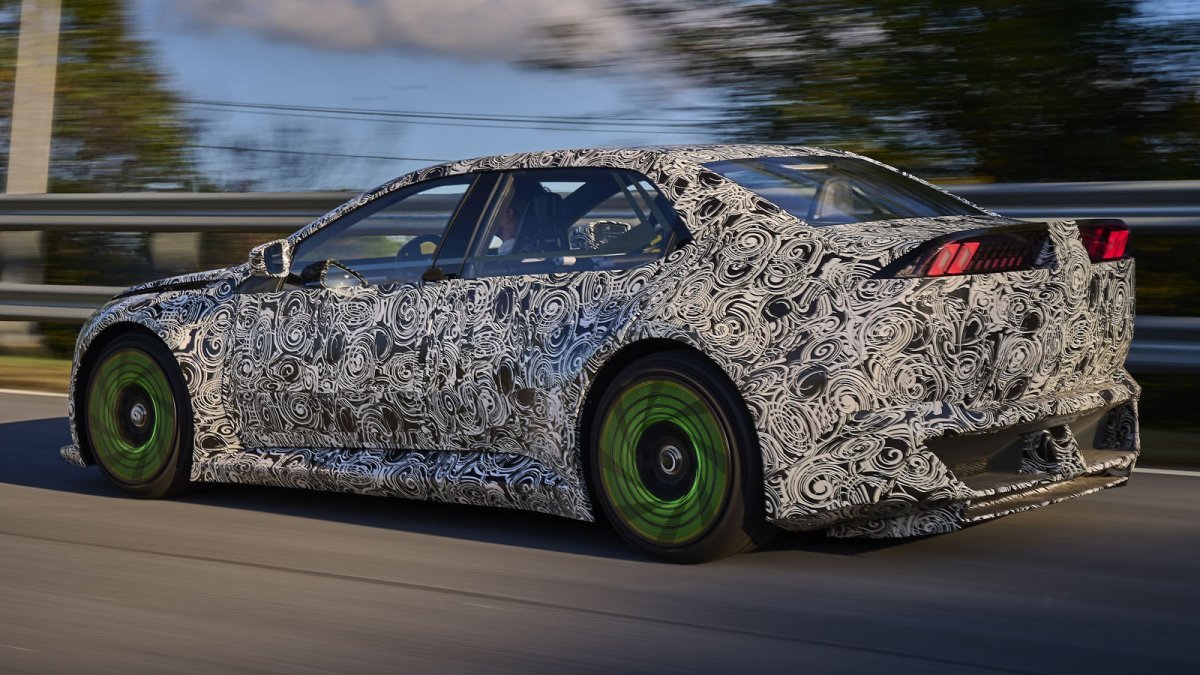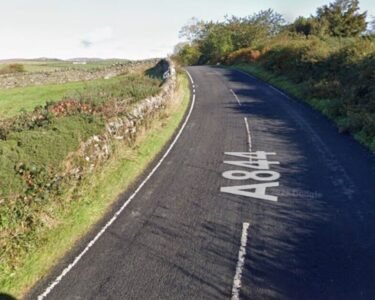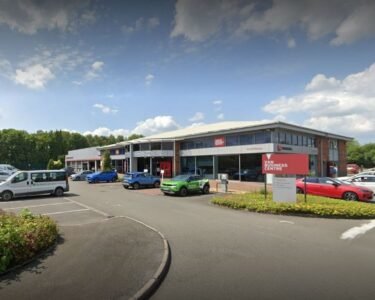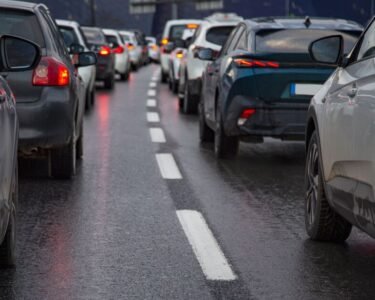Anzeige
Racing driver Jens Klingmann steers the car into a long bend on the test track. From the back seat, I can make out the numbers on the driver’s screen. We drive almost silently at 190 on the test track next to BMW’s US plant in South Carolina. 190 miles per hour – so more than 300 km/h.
“It’s about testing the limits of physics with this vehicle,” says Christian Thalmeier, Driving Dynamics expert at BMW after my test lap. The e-car covered in camouflage foil has no BMW logo on the hood. It will never go into series production. Officially, it bears the three letters VDX. The BMW employees on site call it the Beast. The electric motors deliver a maximum of 18,000 newton meters of torque. To ensure that the car sticks to the ground when cornering, impellers rotate under the vehicle to generate negative pressure. They pull the car onto the road with up to 1200 kg of downforce.
Racing driver at the wheel
You need racing experience to keep such a vehicle on the track. That’s why Jens Klingmann is at the wheel. The 34-year-old is a works driver in the BMW M Motorsport team. Among other things, he has won the Dubai 24 Hours and the Italian GT Championship twice. “What excited me most was the, quite literally, breathtaking acceleration in the VDX,” says Klingmann. I also have a good impression of this after the test lap.
Driving pleasure in a black box
The idea behind this car madness is quickly summarized: “If the Heart of Joy works here, it will master any situation on public roads,” says Thalmeier. The first vehicle in the new class will premiere in the fall of this year, probably an iX3 SUV. However, the system architecture and the operating concept will find their way into all of the manufacturer’s subsequent models. But with the electric variants in particular, some regular customers are asking themselves how BMW is transferring its claim of “driving pleasure” to electric mobility. To provide an answer, BMW CEO Oliver Zipse christened the central computer “Heart of Joy”. From now on, the black box will contain the joy of driving, according to his message.

BMW
)
From 100 to 4
Up to now, cars in the upper class have had more than 100 control units, for example for chassis stabilization and belt tensioners, brakes and airbags. The software on these devices remains unchanged after installation. Linking control units with each other to create new functions is virtually impossible. The choice of control units determines the functions in the car. With the transition to the Software Defined Vehicle (SDV), a paradigm shift is taking place. Software now determines the functions. The lines of code can be changed over the lifetime of a car. Each update brings new functions.
Four computers
If the SDV concept is implemented consistently, a high-performance computer controls all processes in the vehicle. However, very few car manufacturers rely on a single computer that is responsible for both the brakes and the screen. BMW divides the tasks between four computers. One controls the automated driving functions. A second is responsible for the displays and infotainment system. The third takes care of basic functions such as climate, comfort and lighting. Number four is the aforementioned Heart of Joy. Although BMW would certainly call it number one.
The car manufacturer has invested a great deal of effort in its development. The hardware comes from suppliers, but both the concept and the software were realized in-house. BMW wants to claim the SDV principle and thus the software sovereignty in the car of tomorrow for itself. The Heart of Joy controls the drive, brakes and recuperation. It will also take over some steering and charging functions.
Background
From green to blue
The computer can control up to four motors. This could enable BMW to implement all-wheel drive in the foreseeable future. In previous vehicles, separate control units were responsible for the engine and the distribution of the braking effect to the wheels. This is now coming together. The electric motor is not only an efficient drive, it can also be a brake. “We have analyzed the driving behavior of our customers and found that recuperation by the electric motor is sufficient for 98 percent of all braking operations,” says Dahlmeier.
A change from accelerating to braking is now faster and at the same time more energy-efficient. Every time the electric motor slows down a wheel, recuperation generates energy that flows into the battery. “We expect a 25 percent increase in efficiency in energy use,” says Dahlmeier. BMW demonstrates how rarely the friction brakes are still used on the test track with colorful LED lights installed in the wheels. If a wheel lights up green, the car is accelerating. Blue means recuperation. Orange is barely visible. It lights up when a brake pad presses on the brake disk.
Lower latency times
The switch to Heart of Joy also benefits the driving dynamics, as information is transferred ten times faster from the computer to the wheel, brake and motor compared to the old system. According to the manufacturer, the more precise distribution of power to the four wheels provides more traction and superior cornering behavior. Less subsequent control intervention is required, for example when driving through a bend quickly. The track feels more stable and precise to the driver. “Reproducible and therefore more intuitive steering is possible,” says Dahlmeier.
Zone architecture
With the SDV concept, another change is finding its way into cars. BMW relies on zones for the electric-electronic architecture. The car is divided into four zones: front, body (center), rear and roof. The zone controller in the rear, for example, is responsible for sending all control commands to the rear indicators, wheels and trunk lid of the zone.
The big advantage lies in the weight of the wiring. In conventional cars, a wiring harness is the heaviest component in the car after the engine. The commands between the four computers and the zone controllers are transmitted via bundled data lines. This means that wiring for opening the tailgate no longer has to be routed separately through the entire vehicle. Only the route from the zone controller to the respective component is connected with a cable. “In addition to saving weight, cable harnesses can now be produced with a higher degree of automation,” says a BMW spokesperson.
In addition, electronic fuses, so-called eFuses, take over the energy management in the vehicle. BMW has replaced around 150 fuses – with additional benefits: eFuses enable digitally controlled energy distribution. Depending on the driving situation, such as charging, parking or driving, components that are not required can be switched off completely. This is also part of the improved energy efficiency.
More about the brand
(nie)




